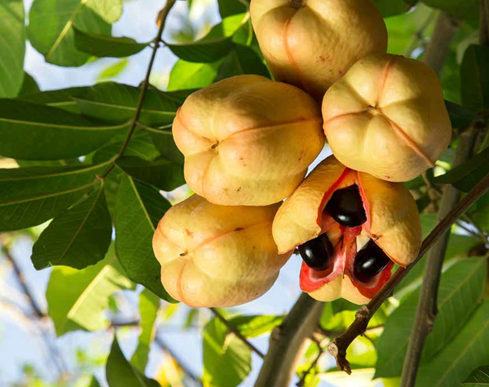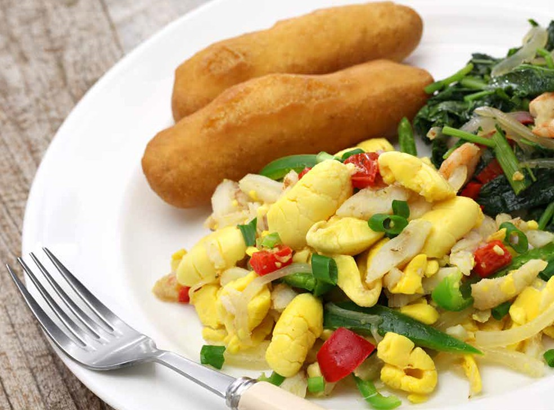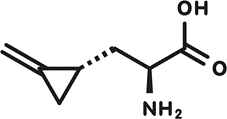Hypoglycin A and Ackee Fruit
Hypoglycin A is a heat stable toxin that occurs in ackee fruit, a tropical fruit used in Caribbean cuisine. Although native to West Africa, ackee fruit is found in south Florida, Central and South America, and many Caribbean countries.
The edible part of a fully ripe, properly processed ackee fruit is safe to eat. Unripe fruit, and the rind and seeds of ripe fruit, are never safe to eat because they can contain dangerous amounts of hypoglycin A.
People who eat unsafe levels of hypoglycin A may have no symptoms or mild symptoms, such as vomiting. However, others can have severe reactions, such as vomiting with profound hypoglycemia, drowsiness, muscular exhaustion, prostration, and possibly coma and death.
A ripe ackee fruit is about 4 inches long. The rind of the ripe fruit is yellow with an overlay of bright red and three seams. As the fruit ripens, it splits open along the seams into three sections revealing the edible part of the fruit, the fleshy, pale yellow arils. At the top of the arils is a round, black, glossy, hard seed. Between the seed and each aril is a pinkish membrane (raphe).
The amount of hypoglycin A in an ackee fruit often depends on how ripe it is and if it was allowed to ripen naturally. A properly ripened ackee fruit will still have high levels of hypoglycin A in its seed and rind, but low levels in its arils. However, a green unripe ackee fruit has high levels of hypoglycin A in all its parts at roughly 1000 parts per million (ppm). If an ackee fruit has more than 100 parts per million (ppm) hypoglycin A, the FDA considers it to be adulterated and unsafe for people to eat.
Ripe ackee can be frozen, canned, or cooked. Most of the ackee products in the U.S. are imported from tropical countries, such as Jamaica, Belize, and Haiti. If an ackee fruit isn’t properly processed, the finished product might still contain enough hypoglycin A to make it dangerous to eat. Because of this danger, the FDA assesses manufacturers of ackee for export to the United States on a plant-by-plant basis prior to considering the admissibility of their ackee product(s) offered for import into the United States. The manufacturers listed on the “Green List” of FDA’s Import Alert have demonstrated to FDA that they have food safety controls in place to ensure that only properly ripened ackees, without seeds or rind, are included in finished products.
If you are planning to eat ackee, here are some things to keep in mind:
- Do not eat fresh ackee that has not ripened naturally.
- Do not try to cook fresh ackee that has not ripened naturally. Cooking an unripe fruit will not reduce the level of hypoglycin A.
- Do not eat the seeds or rinds of ackee. Ripe ackee fruits still have high levels of hypoglycin A in their seeds and rinds.
- Do not try to prepare raw ackee yourself unless you have been trained to properly handle and process ackee.
- When you are buying canned, frozen, or processed ackee products, you can check if the manufacturer is on the “Green List” of processors in the FDA’s Import Alert.
Most processors will buy fruit that is unopened or just beginning to split along the seams. They then typically spread the fruit out on ripening racks to let it finish ripening. Processing staff monitor the fruit, looking for ackee that has split wide open and is ready for processing. If the fruit does not ripen by splitting fully open within three to four days, the fruit is discarded.
When ackee fruit is ripe and splits wide open, there is a dramatic, rapid loss of hypoglycin A in the arils and the raphe. Processors will then remove the black seeds and raphe. Although completely removing the raphe may not always be possible, the amount of hypoglycin A in the raphe is negligible if the fruit has fully ripened.
Problems during processing ackee can result in a finished product with potentially harmful levels of hypoglycin A (more than 100 parts per million). A few examples of processing problems include:
- Employee error in identifying and selecting ackee that is ripe and fully opened
- Heat shocking ackee to make it split open faster rather than allowing it to fully ripen naturally
- Buying ackee that appears ripe, but which may have been opened by the supplier before the fruit fully ripened naturally
- Improper cleaning and washing of the arils
Improperly processed ackee fruit can pose a health risk to anyone who eats it.
Detecting hypoglycin A: To see how much hypoglycin A is in an ackee product, the FDA uses a method called “Reversed-Phase Liquid Chromatographic Detection of Hypoglycin A in Canned Ackee Fruit Sample.” For specifics about this method, please refer to Ware, G., Journal of AOAC International, 85 (4), 2002.
Assessing ackee processors and their products: Before a processor imports their ackee products into the United States, the FDA assesses whether they have food safety controls in place for hypoglycin A. This is done on a processor-by-processor basis and applies to a variety of products such as frozen, canned, or dried ackee, and ackee preserves, beverages, pulp, or toppings. As the FDA assesses whether controls are in place at foreign processors, the FDA places the processor and their products on one of two lists on Import Alert 21-11 “Detention Without Physical Examination of Ackees”:
- The Yellow List, meaning border agents can detain these ackee products without physically inspecting the product (this is called “subject to detention without physical examination (DWPE)”), or
- The Green List, meaning their ackee products are excluded from DWPE.
Our Import Alert page contains more information on what an import alert is and how to understand it.
For guidance on removal from the list for Detention Without Physical Examination, refer to FDA’s Regulatory Procedures Manual, Chapter 9, “Detention Without Physical Examination (DWPE)".
Import Alerts
- Import Alert General Information
- Import Alert 21-11: “Detention Without Physical Examination of Ackees”
- Regulatory Procedures Manual, Chapter 9, “Detention Without Physical Examination (DWPE)"
Guidance Documents
- Compliance Policy Guide Sec. 550.050 Canned Ackee, Frozen Ackee, and Other Ackee Products - Hypoglycin A Toxin
- Hazard Analysis and Risk-Based Preventive Controls for Human Food: Draft Guidance for Industry: Chapter 3
Lab manuals
To learn more about toxins in food, please see our Natural Toxins page.




